Computer-Assisted Language Learning & Media Selection
Computer-assisted language learning (CALL) is the interactive use of technology to foster second language acquisition by providing meaningful opportunities to practice a language in environments beyond that which is available in the confines of a classroom. It began with the stimulus-response of programmed instruction in the 1960s with the programmed logic for automatic teaching operations’ (PLATO) Latin courses for K-16. Nowadays, it’s based on the communicative approach to second language acquisition (SLA) with authentic communication derived from meaningful activities beyond academia. Basically, the use of technology to practice a language in realistic contexts. Of note, non-language related computer learning in general is referred to as computer-mediated learning or computer-assisted instruction.
Computer-based or mobile applications of videogames are one type of CALL media. For example, Trace Effects is a videogame developed by the U.S. Department of State for juvenile English language learners to teach language skills and American Culture abroad. It’s a comprehensive language program based on the communicative approach to language learning (Rogers, 2014). It also has a mobile application called Trace Word Soup for vocabulary development. CALL is not only about videogames. It also includes web-conferencing or other collaborative tools (e.g., blogs, podcasts, Minecraft) in which a person practices learning a language skill (reading, writing, grammar, or speaking) or combination of skills with the assistance of technology while engaging with others in the target language.
The Teaching English to Speakers of Other Languages (TESOL) International Association has a CALL Interest Section that is very active. In fact, their annual, all-volunteer, free Electronic Village Online (EVO) workshop sessions begin January 14th and run for five weeks. See EVO’s 2018 workshop offerings to learn more. I’m the technologist I am today because of the professional development I received from the EVO workshops and self-proclaimed ‘Webheads’. For example, I learned how to script and film movies in SecondLife and prepare an ESL lesson on the machinima (machine made cinema) production. Other professional associations that focus on CALL include EUROCALL and the Computer-Assisted Language Instruction Consortium (CALICO.org).
How do you select the right media for CALL for your students, context, and content? Chapelle (2001) developed the following media selection criteria for CALL: language learning potential, learner fit, meaning focus, authenticity, positive feedback, and practicality. Jamieson, Chapelle, and Preiss (2005) modified these criteria by replacing positive feedback with positive impact. I would include both positive/negative feedback from the computer interactions, as well as its positive impacts. The following excerpt from my SLA dissertation study describes the videogame EverQuest II’s (EQII) potential for CALL based on Chapelle’s (2001) media criteria: (Rogers, 2017, pp. 3-9)
- Language learning potential–Provides text-based and/or live chats with native English speakers, model language from non-player characters (NPCs); written support of all communication in chat logs and speech bubbles (See Figure 1); animated environment to explore, raid, craft a profession, and experience player versus player or solo encounters in battlegrounds or world events; and audible alerts, meters, and signage enhance understanding;
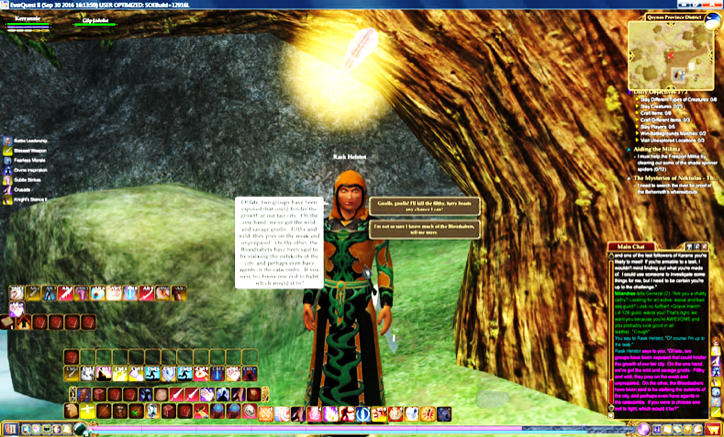
Figure 1. NPC shares information about a quest via speech bubbles. EverQuest® II screenshot image © 2004-2015 Daybreak Game Company LLC
- Learner fit–Current literature indicates promise for massively multiplayer online role-playing games (MMORPGs) for educational purposes; EQII is rated T for Teen (ESRB, 2016) for a more approachable theme; scaffolded introduction to each player’s role;
- Authenticity–Provides 5000 creatures to encounter on 8000 quests for situated learning encounters with NPCs and gamers; possibility of failure (See Figure 2); capability to build your own virtual identity (See blogger’s gamer identity in Figure 3);
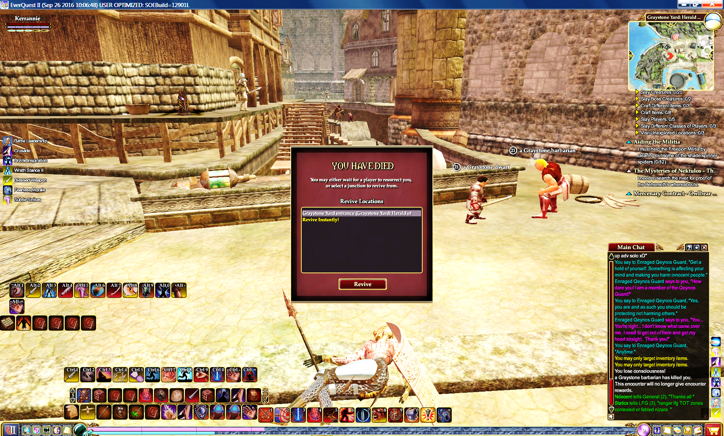
Figure 2. Player character has died in battle. EverQuest® II screenshot image © 2004-2015 Daybreak Game Company LLC

Figure 3. Knight Kerrannie Ironweed inside her home on Frostfang Sea. EverQuest® II screenshot image © 2004-2015 Daybreak Game Company LLC
- Meaning focus–Role-play takes on meaning of several narratives on various kingdoms; encounters provide salutations, skirmishes, and humor (See Figure 4); NPCs provide quests, which serve as a cueing system;
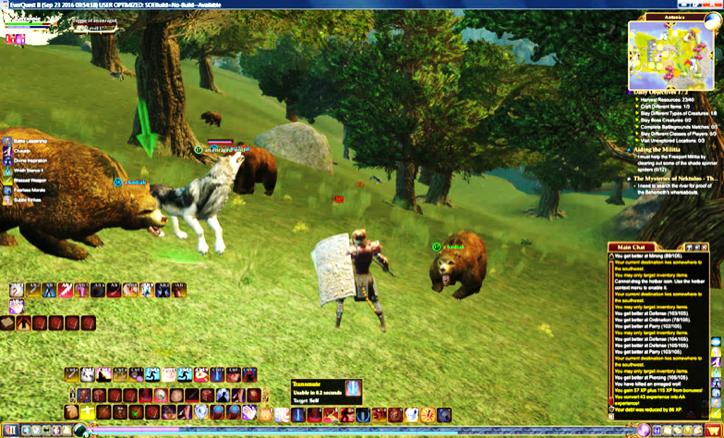
Figure 4. Player character is in a skirmish with animals. EverQuest® II screenshot image © 2004-2015 Daybreak Game Company LLC
- Positive feedback–Provides level-up announcements, tokens for continuance in gameplay, game currency for quest completion (See Figure 5), praise from quest handlers upon completion, and rewards for being courageous; and
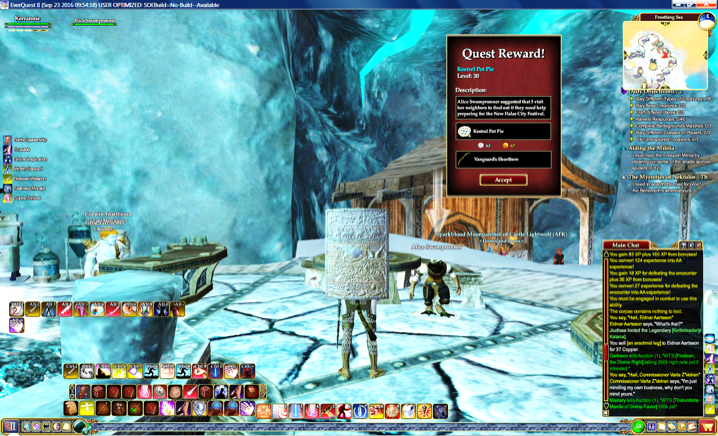
- Practicality–Provides free play; available online for ease of access anytime; tutorials available in-game (See Figure 6 for guide) and online hint books, websites, and community boards; in-game user-friendly tips and error messages provide instant feedback.`
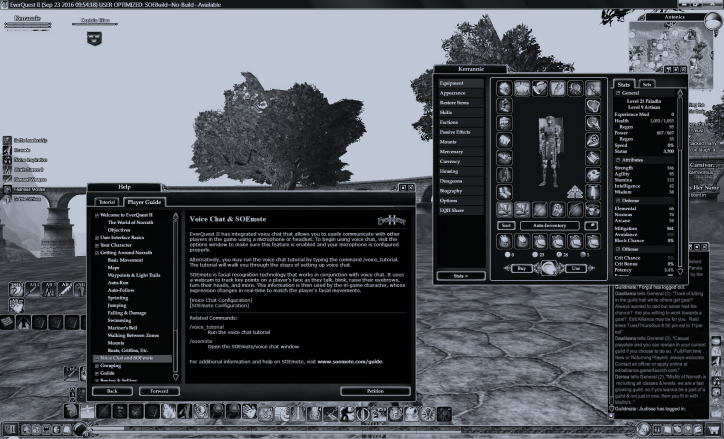
Figure 6. Help from EQII Player Guide on voice chat. EverQuest® II screenshot image © 2004-2015 Daybreak Game Company LLC
References
Chapelle, C. A. (2001). Computer applications in second language acquisition: Foundations for teaching, testing, and research. Cambridge, MA: Cambridge University Press.
Entertainment Software Rating Board. (2016). ESRB ratings. New York, NY: Entertainment Software Association. Retrieved from https://www.everquest2.com/news/february-2016-producers-letter-holly
Jamieson, J., Chapelle, C., & Preiss, S. (2005). CALL evaluation by developers, a teacher, and students. CALICO Journal, 23(1), 93-138. Retrieved from http://lib.dr.iastate.edu/cgi/viewcontent.cgi?article=1045&context=engl_pubs
Rogers, S. (2014). Program theory logic model of Trace Effects video game. Proceedings of World Conference on E-Learning in Corporate, Government, Healthcare, and Higher Education, 1662-1674. Chesapeake, VA: AACE.
Rogers, S. A. (2017). A MMORPG with language learning strategic activities to improve English grammar, listening, reading, and vocabulary (Doctoral dissertation). Available from ProQuest Dissertations and Theses database. (UMI No. 10265484)
